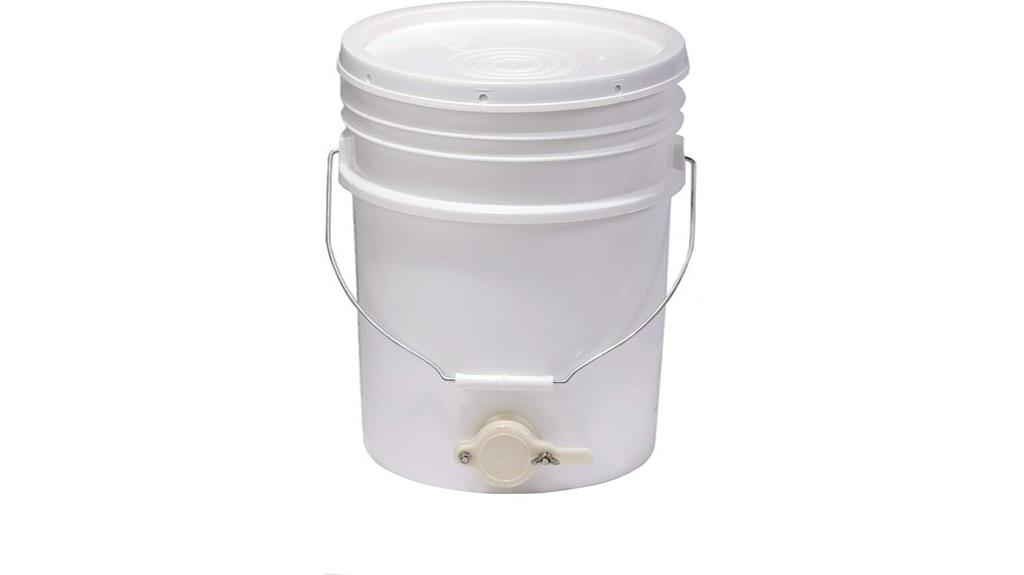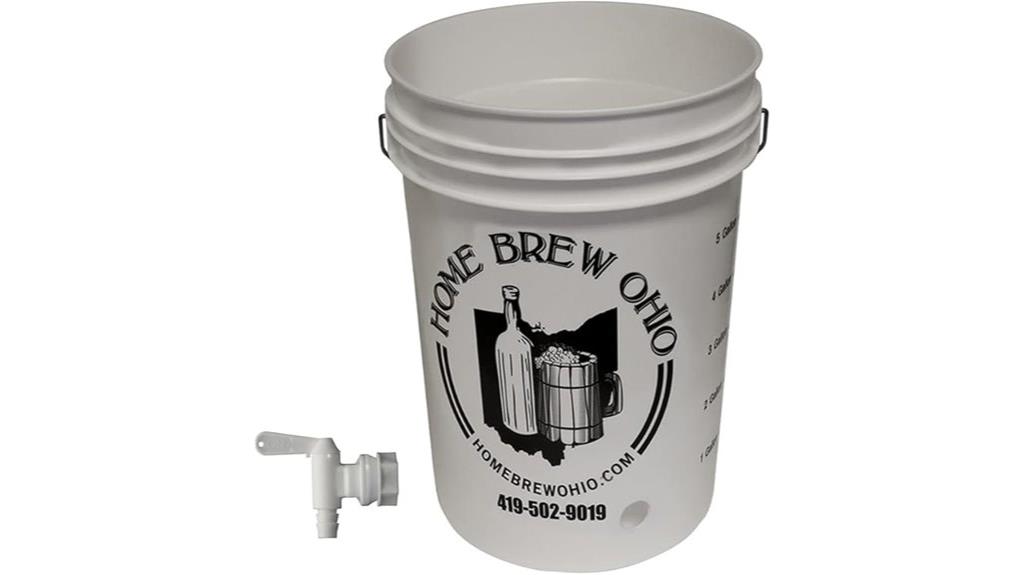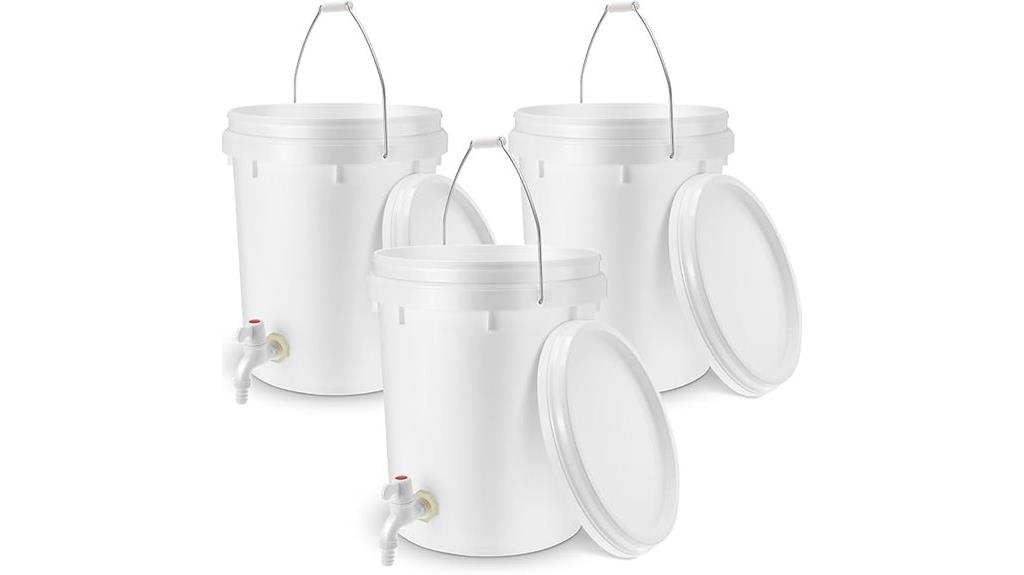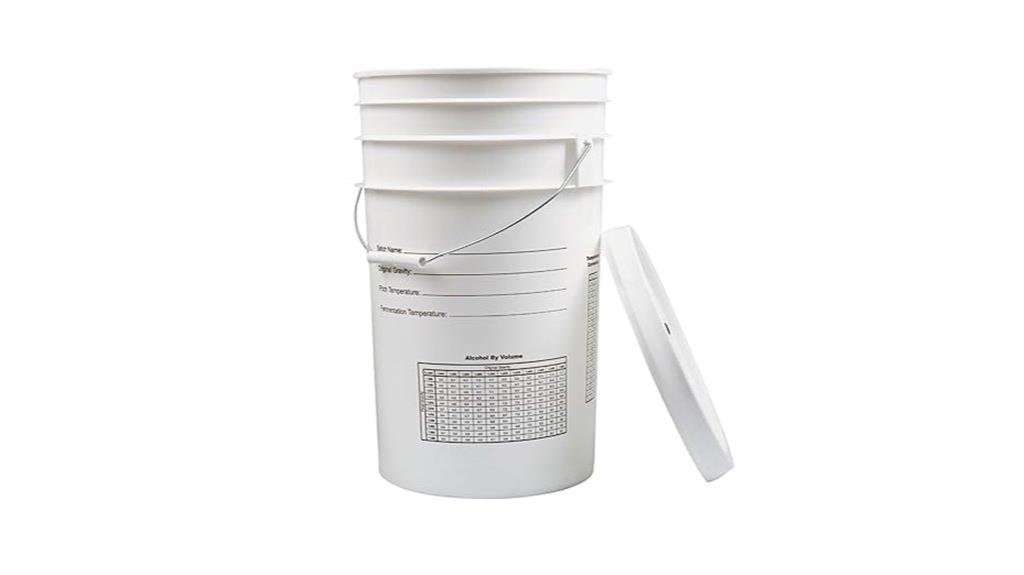10 Best Bottling Buckets for Perfect Home Brewing Results
I’ve tested countless bottling buckets, and the top performers include the Home Brew Ohio 6.5-gallon model with its reliable spigot positioning and dual fermenter capability. The Fastrack 6.5-gallon offers excellent high-krausen beer handling, while budget-conscious brewers appreciate the Maxcheck 3-pack despite some seal issues. Key features I prioritize are food-grade HDPE construction, spigot placement above sediment level, and leak-proof sealing. Capacity matters too—6.5-gallon buckets provide flexibility for various batch sizes. Continue below to discover specific installation tips and maintenance secrets.
We are supported by our audience. When you purchase through links on our site, we may earn an affiliate commission, at no extra cost for you. Learn more. Last update on 25th December 2025 / Images from Amazon Product Advertising API.
Notable Insights
- Choose 5-6.5 gallon capacity buckets made from food-grade HDPE plastic that are BPA-free and meet safety standards.
- Look for spigots positioned above the bucket bottom to minimize sediment transfer during bottling processes.
- Home Brew Ohio 6.5 Gallon offers dual-purpose design with airtight spigot, ideal for beginners seeking reliability.
- Consider installation requirements as some spigots need drilling 1-inch holes, potentially causing permanent bucket modifications.
- Prioritize leak-proof sealing features and quality O-rings to prevent spills and maintain efficient bottling workflows.
6.5 Gallon Bottling Bucket with Lid and Spigot for Bottling Beer

The 6.5-gallon bottling bucket with lid and spigot offers home brewers three essential functions in one affordable package. You’ll find it handles fermentation, bottling, and storage with its strategically positioned spigot sitting one inch above the bucket bottom. This design keeps trub below the spigot level while allowing easy bottling without siphoning equipment.
The printed measurement lines and ABV chart help you track your brewing progress accurately. However, you might encounter some quality issues. The provided O-ring may leak, requiring replacement for proper sealing. The spigot’s length can prevent the bucket from sitting completely flat (requiring minor modifications). While the Italian spigot cleans easily, expect minor leaking when opening.
Best For: Budget-conscious home brewers who want an all-in-one fermentation and bottling solution and don’t mind making minor modifications for optimal performance.
Pros:
- Three-in-one functionality for fermentation, bottling, and storage with no siphoning equipment needed
- Helpful measurement lines and ABV chart printed on sides for accurate brewing tracking
- Affordable price point with durable construction that meets industry standards
Cons:
- O-ring may not seal properly out of the box, potentially causing leaks during fermentation
- Spigot length prevents bucket from sitting flat and may require modification
- Quality inconsistency reported across different orders with some users receiving subpar products
Home Brew Ohio 6.5 Gallon Bottling Bucket with Spigot and Lid

Home Brew Ohio’s 6.5 Gallon Bottling Bucket represents an ideal starting point for newcomers to homebrewing who want a straightforward, mess-free bottling experience. This food-safe plastic bucket weighs just 4 pounds and measures 18 x 12.6 x 10.8 inches, making it easy to handle during bottling sessions. You’ll appreciate the included Vintage Shop spigot, which creates an airtight seal and greatly reduces spills when transferring your beer, wine, or spirits into bottles. The grommeted lid allows you to convert this bucket into a fermenter by adding an airlock if needed. You won’t need any additional equipment to start bottling immediately.
Best For: First-time homebrewers and experienced brewers who want a simple, mess-free bottling solution that can also double as a fermenter when needed.
Pros:
- Vintage Shop spigot creates an airtight seal and significantly reduces spills during bottling
- Versatile design works for bottling beer, wine, spirits, or soda and can convert to a fermenter with an airlock
- Ready to use immediately without requiring any additional equipment
Cons:
- Limited customer feedback with only 2 ratings available to assess long-term performance
- 4-pound weight may be cumbersome when fully loaded with 6.5 gallons of liquid
- Plastic construction may not appeal to brewers who prefer glass or stainless steel equipment
Home Brew Ohio 6.5 Gallon Bottling Bucket with Spigot and Lid

Beginning brewers who want a budget-friendly bottling solution will find the Home Brew Ohio 6.5 Gallon Bottling Bucket offers solid functionality at $28.99. This white plastic bucket measures 18 x 12.6 x 10.8 inches and weighs four pounds, making it manageable for most brewing spaces. You’ll need to drill and install the spigot yourself, which requires separate O-rings and basic tools. The included lid transforms this bucket into a dual-purpose vessel that works for both bottling and fermenting with an airlock. Customer ratings average 4.1 out of 5 stars, though some users report spigot leaking issues after installation.
Best For: Beginning brewers seeking an affordable, dual-purpose bottling and fermenting bucket who don’t mind some DIY assembly work.
Pros:
- Budget-friendly at $28.99 with dual functionality for both bottling and fermenting
- Compact 6.5-gallon capacity suitable for most home brewing spaces
- Included lid allows use as a fermenter with airlock attachment
Cons:
- Spigot requires self-installation with drilling and separate O-ring purchase
- Reports of leaking spigot issues after installation
- Some customers report quality and functionality issues compared to other brands
Little Giant Plastic Honey Bucket with Gate (5 Gallon)

The Little Giant Plastic Honey Bucket with Gate offers home brewers a versatile 5-gallon bottling solution that excels when you need precise control over your dispensing process. This HDPE plastic bucket measures 11.875″ x 11.875″ x 14.75″ and weighs just one pound, making it easy to handle during transfers. The built-in honey gate eliminates messy ladling and provides smooth, controlled flow directly into bottles. You’ll appreciate the secure, tightly fitting lid that prevents contamination during storage. The metal handle ensures comfortable carrying, while the food-grade construction meets safety standards for brewing applications. With 4.6 stars from over 1,500 reviews, this bucket delivers reliable performance for both novice and experienced brewers.
Best For: Home brewers and beekeepers who need a reliable 5-gallon container with precise dispensing control for bottling honey, beer, or other liquids without messy ladling.
Pros:
- Built-in honey gate provides smooth, controlled dispensing directly into bottles or jars
- Lightweight at only 1 pound with sturdy HDPE construction and secure fitting lid
- Food-grade materials with excellent customer ratings (4.6/5 stars from 1,500+ reviews)
Cons:
- Limited 5-gallon capacity may require multiple batches for larger brewing operations
- Some customers have reported lid issues requiring customer service assistance
- Plastic construction may not be as durable as stainless steel alternatives for heavy commercial use
Home Brew Ohio 6.5 Gallon Bottling Bucket with Vintage Shop Spigot-No Lid

Home Brew Ohio’s 6.5-gallon bottling bucket delivers exceptional value for homebrewers who want a reliable, mess-free bottling experience without breaking the bank. This white, food-safe plastic bucket measures 18 x 12.6 x 10.8 inches and weighs just 4 pounds. The vintage shop spigot creates an airtight seal that minimizes spills during bottling sessions. You’ll appreciate its versatility since it works perfectly for beer, wine, spirits, and soda. The durable construction handles multiple brewing cycles with proper cleaning. While you’ll need to purchase a compatible lid separately, this bucket simplifies your bottling process whether you’re a beginner or experienced brewer.
Best For: Homebrewers of all experience levels who want a reliable, mess-free bottling solution for beer, wine, spirits, and soda at an affordable price point.
Pros:
- Vintage shop spigot creates an airtight seal that minimizes spills and mess during bottling
- Versatile design works for multiple beverage types including beer, wine, spirits, and soda
- Durable food-safe plastic construction that can be reused multiple times with proper care
Cons:
- No lid included, requiring a separate purchase for complete functionality
- Basic plastic construction may feel less premium compared to stainless steel alternatives
- Limited 6.5-gallon capacity may not suit larger batch brewing operations
Maxcheck 3 Pack Bucket with Spigot and Lid (5 Gallon)

Budget-conscious brewers seeking an affordable entry point into home bottling will find the Maxcheck 3 Pack Bucket with Spigot and Lid offering three 5-gallon containers at a competitive price point. Each white plastic bucket measures 11.81 x 11.81 x 13.78 inches and includes matching spigots with rubber rings for sealing. You’ll appreciate the sturdy handles for easy transport and the included lids for secure storage. However, customer reviews average 3.1 out of 5 stars, with common complaints about leaking spigots and poor lid fitment. These buckets work well for basic liquid storage beyond brewing, including water dispensing and paint storage, making them versatile for various household applications.
Best For: Budget-conscious users who need basic liquid storage containers for home brewing, water dispensing, or household applications and can tolerate some quality issues.
Pros:
- Affordable three-pack offers good value with 15 gallons total capacity
- Versatile design works for brewing, water storage, paint, and various liquids
- Includes all necessary components with spigots, lids, and rubber sealing rings
Cons:
- Poor customer satisfaction with 3.1/5 star rating due to quality issues
- Common problems with leaking spigots affecting functionality
- Difficulty with lid fitment and assembly challenges reported by users
Fastrack 6.5 Gallon Fermenting Bucket with Lid for Beer & Wine

Serious home brewers who tackle high-krausen beers need extra headspace during primary fermentation, making this 6.5-gallon capacity bucket an ideal choice for your brewing setup. Made from food-grade HDPE that’s 100% BPA free, this bucket handles beer, wine, mead, and cider with reliable durability. You’ll appreciate the pre-drilled lid grommet for airlock installation and the included specific gravity chart for tracking fermentation progress. The lightweight construction makes handling easier, though you should expect the lid to be single-use only. While it costs more than local alternatives, this bucket delivers consistent performance for serious brewers.
Best For: Serious home brewers who make high-krausen beers and need reliable fermenting equipment with ample headspace for primary fermentation.
Pros:
- Made from food-grade HDPE that’s 100% BPA free with sturdy, leak-resistant construction
- Includes pre-drilled lid grommet for airlock and specific gravity chart for tracking fermentation progress
- Lightweight design makes handling easier during brewing and cleaning processes
Cons:
- Lid is designed for single-use only, requiring replacement after opening
- Higher price point compared to similar products available at local brewing shops
- Tall and narrow design makes pouring and transferring more difficult than wider buckets
Factors to Consider When Choosing Bottling Buckets
When I’m selecting a bottling bucket for my homebrewing setup, I need to evaluate several key factors that directly impact my brewing efficiency and final product quality. The bucket’s capacity must match my typical batch sizes, while the spigot’s construction and placement determine how smoothly I can transfer my beer without creating sediment disturbance. I also consider the bucket’s material safety standards, lid sealing capabilities, and assembly requirements to guarantee I’m investing in equipment that’ll serve my brewing needs reliably.
Capacity and Size Options
Several key factors determine which bottling bucket capacity works best for your homebrewing setup. I recommend starting with the most common sizes: 5-gallon and 6.5-gallon buckets. The 6.5-gallon option gives you more flexibility for larger batches, making it ideal whether you’re just starting out or you’ve been brewing for years.
Consider the physical dimensions carefully before purchasing. Standard 6.5-gallon buckets typically measure around 18 x 12.6 inches, so make certain this fits your available storage space. Height matters too – taller buckets can make pouring and transferring liquids more challenging, especially if you’re working with limited counter space.
Match your bucket capacity to your typical batch sizes and available equipment to guarantee smooth brewing operations.
Spigot Quality and Positioning
The spigot represents the most critical component of your bottling bucket since it directly controls the flow and quality of your finished beer. I recommend choosing buckets with spigots positioned approximately 1 inch above the bottom, which allows easy bottling while keeping sediment and trub out of your bottles.
Quality spigots feature airtight seals and gaskets that prevent leaks during filling. However, many brewers find they need additional O-rings or modifications to achieve proper sealing effectiveness. I’ve noticed that poorly constructed spigots create messy bottling sessions and potential contamination risks.
Look for spigots that disassemble easily for thorough cleaning and maintenance. This feature greatly impacts your brewing hygiene and overall convenience. Investing in a bucket with a well-designed, properly positioned spigot saves time and frustration during every bottling session.
Material and Food Safety
Beyond spigot considerations, food-grade plastic construction forms the foundation of any reliable bottling bucket. I always choose buckets made from HDPE (High-Density Polyethylene) because this material offers excellent durability and chemical resistance for repeated brewing cycles. Food-safe plastics are specifically designed to be BPA-free, which prevents harmful chemicals from leaching into your beer or wine. Quality materials won’t impart unwanted flavors or odors that could ruin your carefully crafted brew. When shopping, I look for buckets with food safety certifications clearly marked on the product. These certifications provide additional assurance that the bucket meets strict safety standards for handling consumable products. Don’t compromise on material quality – your beer’s safety and taste depend on it.
Lid Fit and Sealing
While material quality provides the foundation, a properly fitting lid creates the secure seal that protects your brew from contamination throughout the entire process. I’ve found that poorly fitting lids cause frequent headaches, leading to leaks and lost carbonation in your final product. When you’re using drilled grommets for airlocks, even small gaps can expose your brew to harmful bacteria and wild yeast.
Different brands often have inconsistent lid designs, so I recommend testing the fit before committing to a purchase. Look for lids that seal firmly without requiring excessive force. You’ll also want to evaluate how easily you can remove the lid when it’s time to bottle. Some create such tight seals that opening them becomes a two-person job (not ideal during solo brewing sessions).
Installation and Assembly Requirements
Once you’ve found a bucket with a secure lid, installation requirements become your next major consideration since most bottling buckets require some assembly before you can start brewing. I’ve found that many buckets need you to drill a 1-inch hole for the spigot yourself, which can be tricky depending on the design. Some manufacturers include pre-installed spigots to save you time and reduce installation errors. You’ll likely need gaskets or O-rings to create a proper seal and prevent leaks. Don’t forget about additional tools like wrenches or sockets, which usually aren’t included in the package. Proper spigot alignment is essential—poor positioning leads to leakage and frustrating bottling sessions.
Frequently Asked Questions
How Do You Properly Sanitize a Bottling Bucket Before Use?
I sanitize my bottling bucket by first cleaning it thoroughly with warm soapy water to remove any residue. Then I prepare a no-rinse sanitizer solution like Star San following package directions (typically 1 ounce per 5 gallons of water). I fill the bucket completely with sanitizer, let it contact all surfaces for two minutes, then drain it completely before use.
What’s the Difference Between Bottling Buckets and Primary Fermenting Buckets?
I’ll explain the key differences between these two bucket types. Primary fermenting buckets hold your wort during initial fermentation, typically for 5-14 days. They need tight-fitting lids with airlocks to prevent contamination. Bottling buckets have spigots near the bottom for easy dispensing and usually include volume markings. You’ll transfer finished beer from your fermenting bucket to the bottling bucket for final packaging.
Can You Use a Bottling Bucket for Secondary Fermentation?
I don’t recommend using a bottling bucket for secondary fermentation. The spigot creates a potential contamination point and makes thorough cleaning difficult. Secondary fermentation requires an airtight seal with minimal headspace, which bottling buckets don’t provide effectively. You’re better off using a proper carboy or fermenting bucket without a spigot for secondary fermentation to maintain beer quality.
What’s the Ideal Height Difference Between Fermenter and Bottling Bucket?
I recommend positioning your fermenter 18-24 inches above your bottling bucket for ideal gravity flow. This height creates enough pressure to maintain steady transfer without excessive force that could cause splashing or oxidation. If you’re working with limited vertical space, 12 inches minimum will work, though the flow rate will be slower and require more patience during transfer.
On a final note
I’ve covered the top bottling buckets that’ll make your home brewing smoother and more efficient. Each option offers different features, from spigot quality to bucket capacity. Consider your batch size, budget, and brewing frequency when making your choice. A good bottling bucket reduces sediment transfer and makes the bottling process much easier. Pick one that matches your brewing setup, and you’ll see improved results in your finished beer.
